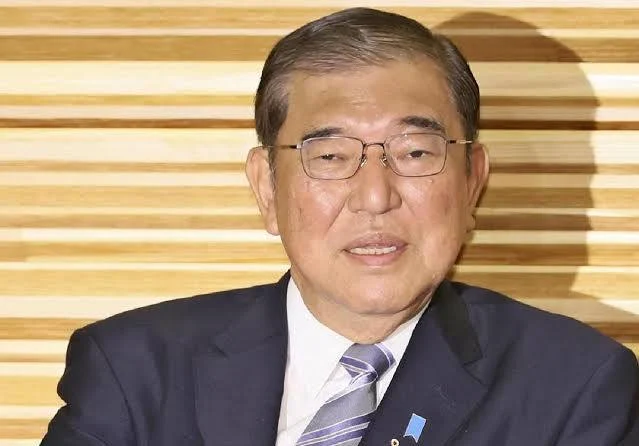
Post-election, Ishiba Shigeru continues to appear on television screens as the incumbent Prime Minister of Japan. The sheen of perspiration on his brow is not just the heat of this extraordinarily hot summer, but shows the pressure he is under following the election result on 20 July. Despite efforts to claim the successful outcome of tariff negotiations with the Trump administration in Washington as a sign of his leadership strength, the Ishiba critics continue to raise their voices.
I spent a few hours in the national library in Tokyo on Wednesday, and finished there in time to take the long way round to Nagatacho Station, past the Liberal Democratic Party headquarters. This was just after Ishiba’s meeting with former prime ministers and party heavyweights, Taro Aso, Yoshihide Suga and Fumio Kishida.
There was a strong police presence, a couple of outside broadcast vans, and one lone protestor shouting into the thick humid air to no-one in particular, and everyone walking past. I was almost bowled over by one of the “young” LDP members running through the gate.
Watching the “success” of the right-wing Sanseito party in the Upper House election, with its Trumpian rhetoric and appeal to younger voters, the LDP youth bureau members have been assembling to call for changes at the top.
It reminded me of my 1980s honours thesis – about a group of youth bureau members gathering to challenge the leadership and calling for changes to the way the LDP does politics. Forty years ago. Interestingly, one of the youngest of that group from 1985 is still in parliament and now an elder of the party.
The media is reporting he is in favour of Ishiba staying on as leader. Ironically, one of the contemporary “young Turks” is the grandson of former prime minister Nakasone Yasuhiro.
The Sanseito party continues to attract interest and analysis in the media this week. But rather than see it as some new phenomenon, it is more a continuation of the politics of the nationalist far-right that has existed for decades. Certainly, its canny use of social media has given the party a particular cachet this time, but that is consistent with a trend worldwide.
On these same streets of Nagatcho as a graduate research student all those years ago, it was commonplace to be blasted by the loudspeakers of the big black trucks circulating the parliamentary perimeter, shouting their slogans and telling the LDP to move more to the right. More than once, I was shouted at to “go home, foreigner”.
In more contemporary times, “traditional” Japanese parties have been challenged by the Osaka-based Ishin no Kai, the skittish (anti-)NHK party, and all sorts of pesky candidates seeking attention in various ways.
They turn up at every election and usually fade away before the ubiquitous election posters are taken down. It will take another election cycle to measure the staying power and influence of this new party.
Clearly there are intense negotiations going behind the scenes, to find an agreed way for Ishiba to make a dignified exit.
Over the last few days I’ve been speaking with a range of friends and colleagues, anecdotally, about the current situation.
Of the two leading candidates to replace Ishiba, neither Koizumi Shinjiro nor Takaichi Sanae are considered prime ministerial material. People are concerned that a Takaichi government would lurch further to the right, while a Koizumi government would be, well, they can’t picture it, and certainly don’t think it would be better than Ishiba.
There is discontent with Ishiba and the LDP, but they ponder the consequences of a change yet again.
The consequences of the tariff negotiations are yet to play out domestically. The reactions thus far have been mixed: relief perhaps that the US tariffs are limited to 15 per cent, but at the same time uncertainty and concern about the costs that might be incurred by manufacturers here.
While Ishiba and his chief negotiator Akazawa Ryosei, minister for economic revitalisation in Ishiba’s cabinet, hail the negotiations as a success and in the national interest, Japan, like the rest of the world, continues to try and second guess the inconsistent and erratic Trump administration.
A few days on from the election result, Ishiba has held on longer than we might have expected. Clearly there are intense negotiations going behind the scenes, to find an agreed way for Ishiba to make a dignified exit. There might also be a snap election – another one.
Applying a long lens to Japanese politics, to look back and then look forward, a change in prime minister now is unlikely to “fix” the problems that confront the country.
The more distant the parties are from the people who elect them, the more they will fail at the ballot box. This degree of democratic fatigue is not limited to Japan. There are deep lessons for democracies throughout the world.




